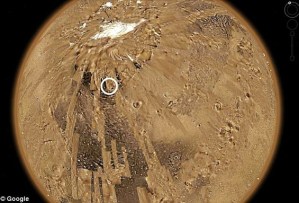
Mars has fascinated humanity since pre-historic times, but the notion of little green men and Martian Society really got its start in the 19th century when Italian astronomer Giovani Schiaparelli noted “canali” on the visible surface of Mars. American Percival Lowell took the idea much further from 1885 to 1908 with a series of three books detailing his observations of the Martian surface and the intelligent civilization that he believed existed there. Now in the 21st century a man named David Martines claims to have found evidence of intelligent life on Mars—this time in the form of a long cylindrical base. And he didn’t find it with a telescope: He found it using Mars surface imagery available via Google Mars.
According to Martines’ calculations, the object is more than 700 feet long, 150 feet wide, and has red and blue strips on its white surface. He’s dubbed the visible anomaly “BioStation Alpha” because he assumes it either housed or houses living creatures.

“It could be a power station or it could be a biological containment or it could be a glorified garage—hope it’s not a weapon,” Martines says in a video he posted to YouTube. Martines speculates the station could belong to the U.S. NASA space agency, but doubts it would be possible for humans to get that much material to Mars in secret. “I don’t know if NASA even knows about this.”
Before jumping to the conclusion that aliens have set up a surveillance post to watch I Love Lucy reruns as they whisk past the Red Planet, it’s important to note that Google’s Mars imagery pulls from information published under the JMARS data project, and is comprised of different types of filtered imagery from a number of different sources and probes from present day (like Mars Global Surveyor and Mars Odyssey) all the way back to the 1960s and 70s. Google has also done some of its own work on the imagery, adding high-resolution images from infrared and other sources to heighten detail on points of interest. Imagery in Google Mars is far from a high-resolution photograph: It’s an enormous amount of highly-specialized, highly-processed data from a number of sources cleverly stitched together to resemble a 2D or 3D flyover of Mars.
Mars enthusiasts looking to follow up on Martines’ discover should have little difficulty finding other visual anomalies in Google’s Mars presentation. A few minutes of random searching in the area surrounding Martines’ discovery—at 49’19.73″N 29 33’06.53″W—turned up a few more suspicious blips nearby. All in all, Martines’ discovery—and the media’s reaction to it—may serve as a testament to how badly humans want to believe there’s life on Mars
Martines has removed his original videos announcing the discovery from YouTube, but a few sites still have them available.


